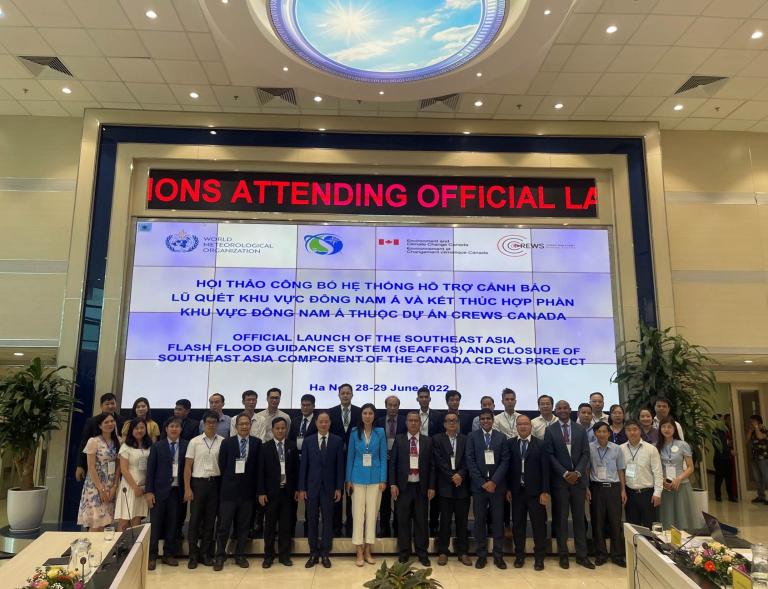Improving early warnings in the Caribbean, Pacific and Southeast Asia
A successful six-year, 10 million Canadian dollar project, funded by Environment and Climate Change Canada (ECCC), has strengthened the quality and availability of impact-based forecasts and services to support communities in Southeast Asia, the Caribbean, and the Pacific.

A successful six-year, 10 million Canadian dollar project, funded by Environment and Climate Change Canada (ECCC), has strengthened the quality and availability of impact-based forecasts and services to support communities in Southeast Asia, the Caribbean, and the Pacific.
The project, which was launched in 2016 under the framework of the Climate Risk and Early Warning Systems Initiative (CREWS), supported capacity building of National Meteorological and Hydrological Services (NMHSs) to provide more accurate and timely forecasts, including effective, risk-informed multi-hazard early warning services to vulnerable populations in 35 countries.
It fulfilled three key objectives:
- Strengthen coordination and communication between Multi-Hazard Early Warning Systems stakeholders;
- Enhance the capacities of WMO Regional Centres and participating NMHSs to forecast severe weather, flash floods and coastal inundation;
- Provide regional and in-country technical assistance to NMHSs to develop and deliver impact-based products and services.

The Building Resilience to High-Impact Hydro-Meteorological Events Through Strengthening Multi-Hazard Early Warning Systems in Small Island Developing States and Southeast Asia (Canada CREWS) was centred around strengthening and leveraging WMOs network of regional centres in order to downscale support to members at the national level and promote multilateral cooperation.
This was done by sponsoring WMOs flagship initiatives including the Severe Weather Forecasting Programme (SWFP) which makes available Numerical Weather Prediction (NWP), using global data and models, the Flash Flood Guidance System (FFGS), which provides a series of products in near real-time in order to provide guidance on flash flood events, and the Coastal Inundation Forecasting Initiative (CIFI) which builds improved operational forecast and warning capability for coastal inundation from combined extreme waves, surges and river flooding events .
WMO Director of Member Services, Filipe Lúcio indicated, “Multilateral cooperation was prioritized as it was recognized that cooperation amongst member states is critical across the three regions. This is due to the transboundary nature of hazards. Enhanced cooperation and collaboration amongst member states was a significant achievement of the Project. This was made possible by leveraging WMO’s network of regional centres and the transboundary nature of the programmes being implemented through the Project including SWFP and FFGS.
Main achievements of the project include:
- Development and implementation of the Southeast Asia Flash Flood Guidance System, the first regional FFGS with nowcasting products and real-time and historical data inputs from various sources, providing information with a lead time of up to 36 hours;
- Establishment of the Flash Flood Guidance System for Fiji, one of the most advanced systems developed to date;
- Development of an offshore wave and coastal inundation forecasting system with risk information and warning services in Kiribati (Tarawa) and Tuvalu (Pacific SIDS) ;
- Development of a fully integrated Riverine Flood Forecasting System for the Dominican Republic;
- Implementation of community based early warning and activities to prepare and respond to impact-based forecasts and warnings in the Pacific SIDS
- Over 150 NMHS staff personnel trained across all three regions covering a wide range of activities: Impact Based Forecasting, Severe Weather, Flash Floods, Common Alerting Protocol, Regional Climate Data, Analysis and Projections.
To formally close the project, WMO staff joined regional representatives from Cambodia, Lao People’s Democratic Republic, the Philippines, Thailand and Viet Nam from 28 - 29 June at Viet Nam Meteorological and Hydrological Administration headquarters in Hanoi, Viet Nam, for at workshop.
The event provided a platform to highlight achievements and lessons learnt from the project, discuss sustainability of project outcomes and future activities and formally close the project. It also saw the official launch of the Southeast Asia Flash Flood Guidance System, which has now transitioned into an operational phase.
"The Viet Nam Meteorology and Hydrology Administration is honored to be selected as the Regional Center for the SEAFFGS through the support of WMO, member countries and the Canada CREWS Project. This will support capacity building in flash flood warning in Southeast Asia with advance technology, integrating multiple data sources from member countries, including nowcasting data, automatic real-time observation…calculation of flash flood threshold index in 6 hours, warning of flash flood risk in 36 hours, landslides threshold in 24 hours, contributing to mitigating damage caused by flash floods and landslides in member countries,” said its administrator, Prof Tran Hong Thai.

Activities to improve warnings of severe weather, flash floods and coastal inundation will continue beyond the lifetime of the Canada CREWS project as WMO continues to engage with the benefitting NMHSs. To further ensure the sustainability of actions, the forecasting capacities and national Multi-hazard Early Warning Systems of countries in Southeast Asia and the Pacific were fully assessed and long terms strategies and action plans for the NMHSs were developed.
These plans are already being put into action through new initiatives like the CREWS Cambodia and Laos People’s Democratic Republic project, which not only sustains and but also enhances action taken through the Canada CREWS project.
“By implementing activities under this new project, the Department of Meteorology and Hydrology can upgrade and strengthen many functions such as equipment, weather analysis and forecasting tools, and capacity building. As a result, the trust of our citizens and authorities will increase,” said Lao People’s Democratic Republic representative Bounteum.
For more information on the Canada CREWS project:
Project Webpage
ECCC
Environment and Climate Change Canada is the lead federal department for a wide range of environmental issues. (Link)
CREWS
The CREWS initiative is an international partnership that aims to strengthen risk information and access to early warning systems in vulnerable countries, and to leverage financing to protect populations exposed to extreme climate events. (Link).
- Membre de l'OMM:
- Canada ,
- Cambodia ,
- Lao People's Democratic Republic ,
- Philippines ,
- Thailand ,
- Viet Nam ,
- Fiji ,
- Dominican Republic ,
- Kiribati ,
- Tuvalu



